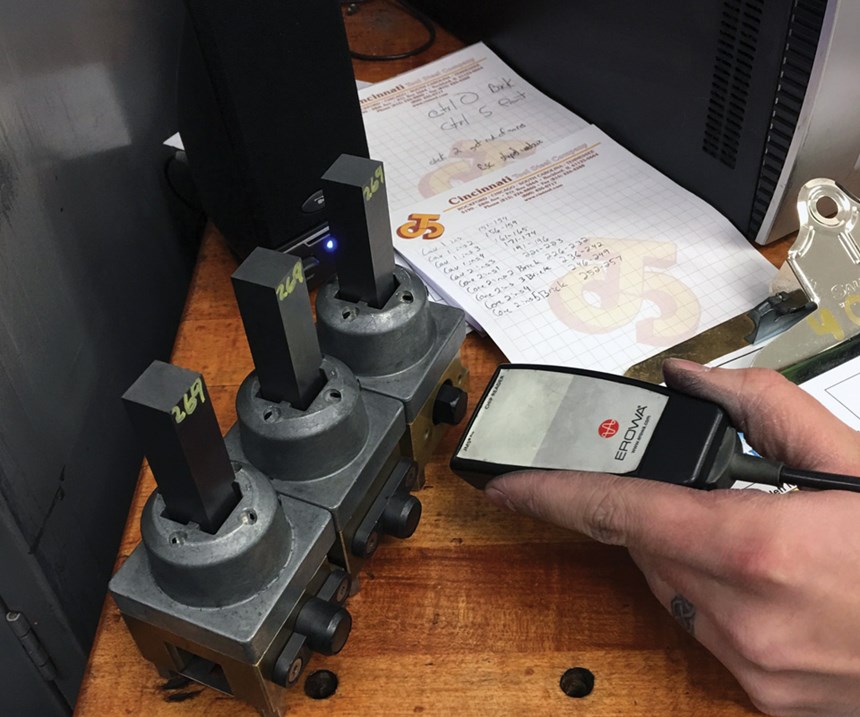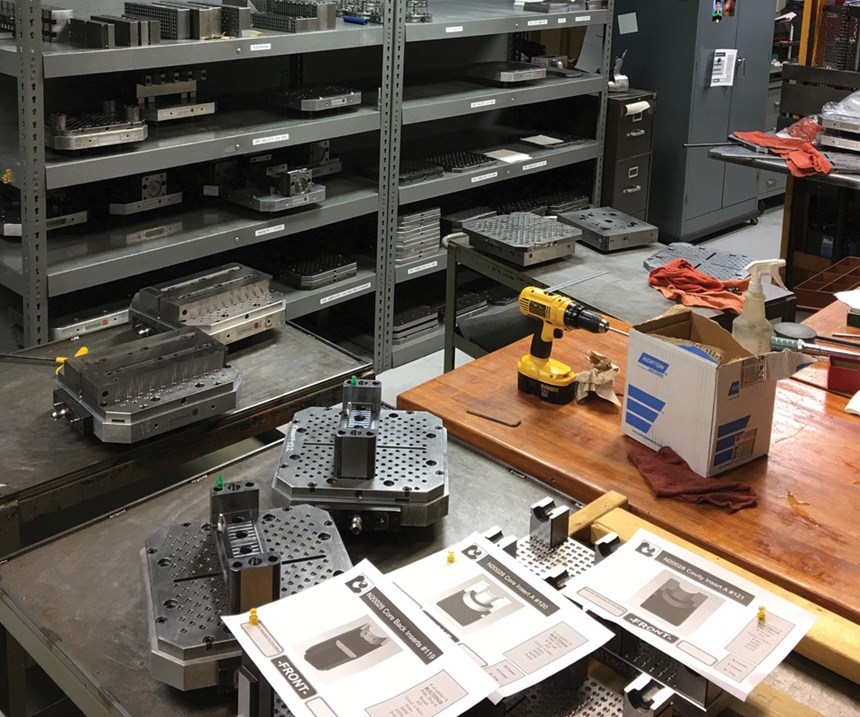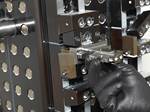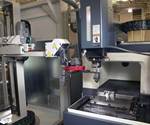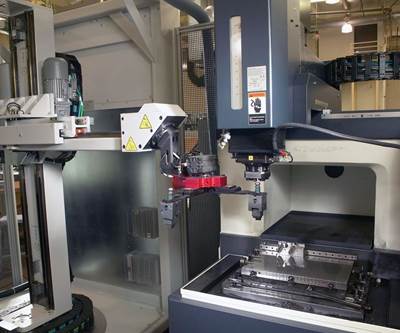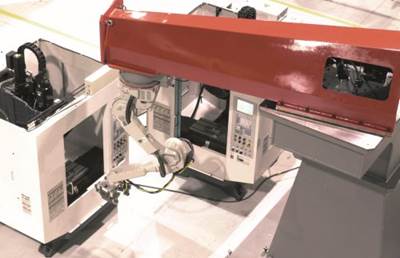Powerful Production
Automated cells with RFID technology facilitate a “productionized” approach that helps this shop make molds more accurately and efficiently.
Tim Peterson was most interested in seeing one thing when he walked the halls of Chicago’s McCormick Place during last year’s International Manufacturing Technology Show: automation.
This single-minded focus was a bit surprising until it was explained. Peterson’s company, Industrial Molds Inc., of Rockford, Illinois, had been employing automated machining cells since 2002, when it purchased a Bostomatic CNC machine integrated with an Erowa Technology Inc. 60-position robot for carbon-cutting applications. Finding the robot system to be user-friendly and powerful, the company soon decided to expand automation to its EDM department, purchasing two Charmilles Roboform 550 sinker EDMs integrated with an Erowa ERS robot.
In 2004, Erowa introduced the company to its new JMSpro JobManagement software and demonstrated how it works in tandem with radio frequency identification (RFID) technology to manage automated machining. Small RFID chips are installed within an automated cell to manage the movement of workpieces within it, without requiring any extra action by operators or special programming. “We weighed out the costs versus the benefits and recognized its value,” says Peterson, Industrial Molds vice president. “The addition of that system sparked an evolution of thinking and process development that has helped us get where we are today.”
Moldmakers typically are not production workers, nor are their companies regarded as production machining houses, but Industrial Molds has found that adopting a “production mindset” by pairing Erowa’s RFID chips and integrated JMS software with automation is the key to building molds more accurately and efficiently. Today, the chips are installed in the company’s array of Erowa pallets and electrode holders to help systematically move workpieces through the shop’s now-four automated machining cells according to detailed “routing plans” that have been laid out by its manufacturing team.
In addition to the Charmilles cell, Industrial Molds’ 50,000-square-foot facility currently is equipped with a high-speed milling cell featuring Makino S56 and F5 CNC machining centers connected by an Erowa ERS robot; a carbon-cutting cell (which replaced the Bostomatic cell) consisting of a Mikron UCP 600 Vario 3+2 and HSM 400U LP five-axis CNC machines with an Erowa Robot Multi that can hold as many as 200 electrodes; and a new EDM cell with two Sodick AG60 sinker EDMs integrated with an Erowa Robot Dynamic ERD—all of which can run unattended, 24/7.
As is the case with most mold shops, no two molds of the roughly 125 that Industrial Molds builds annually for the automotive, consumer, medical, lighting and industrial markets are alike. Deadlines are continually changing, and the way each workpiece is planned for production seems to be unique from job to job. “This is what makes mold manufacturing both fun and challenging at the same time. But it’s also the reason we automated our moldmaking processes,” says Wes Stephens, account manager. “At any given time, we might have 40 to 50 jobs being worked on in our shop. RFID-chipped workholding enables us to more finitely control the automated processes, and this is where I believe Industrial Molds is substantially different than other shops.”
Preplanning
However, for automation with RFID technology to work correctly and be effective, key steps must be taken, Stephens says, and the first of these is preplanning. “We are very system-heavy when it comes to how work is planned and moved through the shop, mainly because past experiences have taught us valuable lessons about the importance of communications,” he says. Thus, every job begins with a planning and routing meeting that includes account managers, engineers and project leaders, production and automation managers, and department heads.
During this meeting, Jeff Noud, automation manager, creates a PowerPoint file containing a routing/planning sheet for each workpiece that makes up the mold. By committee, the group determines how it wants the workpieces to be oriented on the RFID-chipped pallets for pick up by the coordinate measuring machine. Deciding on this is a critical step, since each department will base all of its programming off of this orientation. Other discussions during this meeting entail which details will be ground and which will be roughed out, and which of the workpieces can be high-speed milled or will require electrodes.
“The PowerPoint is a huge communications tool because it eliminates ambiguity,” Noud says. “Your idea of upright and mine might be different, for instance, but the PowerPoint illustrates through drawings and exacting measurements precisely what it means so that there’s no question. And because everything is documented in the PowerPoint, there’s more traceability and accountability.”
Pallets and Prioritization
As important as a routing plan is, the pace and prioritization of jobs within each department are equally as important. “It would not be very productive to have all the work sitting in one department while the other departments have nothing to do,” Noud says. Instead, critical-path components, usually cores, cavities and slides, are processed first, followed by less-critical components. The use of JMSpro with the RFID chips allows Industrial Molds to easily prioritize workpieces as they move through the automation cells by simply assigning them each a priority number between -99 to +99 in the JMS. “Our managers are always looking at each department’s capacity,” Stephens says. “They typically plan for about 80 percent new work, because it’s important to also leave capacity for engineering changes and the ensuing tool grooming as well.”
Not every workpiece in every job is suited for production by an automation cell. Some are just too large to fit within the 12-by-12-by-6-inch size limit of the pallets, and Industrial Molds has several other machining centers and operators available to accommodate those workpieces. When a workpiece does fit, it is cleaned of contaminants and carefully clamped onto a pallet according to the orientation specifications agreed to during preplanning, and then sent to the company’s CMM department. There, the JMSpro software is used to create a “tree” or diagram of the order in which each process will be performed on the part. The workpiece is scanned and a touch probe is used to record X-, Y-, Z- and C-axis locations. This offset data is then loaded into the software so that when the RFID chip in the pallet holding the workpiece is scanned in other areas of the shop, it will show exactly how the workpiece is oriented on the pallet, similar to determining a machine offset. Noud says. “Those offsets carry through the CMM inspection process, high-speed machining and EDM departments, and the advantage is there’s no longer a need to use valuable time indicating every insert every time the job moves to another department,” Noud says. “The workpiece is picked up one time and does not come off the pallet until it passes inspection.”
Finally, every process specified for a workpiece is color-coded through use of colored magnets to ensure, at a glance, that it is routed through the shop in the correct order as determined during preplanning. For example, yellow signals that a part should be sent to the high-speed machining department, blue means EDM, and red means the next stop is five-axis machining. “Regardless of where a workpiece is sent in our facility, the key is that everything is systems-based, and critical data is stored with every mold component using RFID chip technology,” Stephens says.
In preparation for a workpiece, machine operators import NC programs created by the programming department into JMSpro using Sodick LN Series control, Charmilles DP control and Autodesk PowerMill. Once imported, they are synced to corresponding RFID chips, building on the workflow trees that were first created in the CMM department. The operator places the pallet into the carousel, and the robot in the automation cell uses RFID scanners to identify each workpiece. When it finds the correct workpiece, it loads it into the machine that has been designated to process the job, according to the priority set in the software.
If, after a machining process is completed, the workpiece needs to be rechecked for accuracy, it is sent back to the CMM department, pertinent data is retrieved from the RFID chip, and the workpiece is measured while still on the pallet. “All of this saves an incredible amount of time for everyone involved,” Noud says. “Other companies that use palletized workholding can do in-process inspections, too, but if they don’t also use RFID technology, they have to manually type workpiece offsets into the machines and verify the job data every time a new machine or CMM inspection is ordered. This can be very inefficient in implementation, plus it leaves a lot of room for error.”
“We ship molds we build all over the world, and each mold is strategically planned out by our team leaders, from the time that mold gets released by the customer to the day it is finished and shipped out the door,” Stephens says. “Not only has our automation, RFID chip technology and machine precision reduced lead times, it also has allowed us to duplicate replacement components quickly and with great accuracy. The implementation of, and continuous investment in, automation working in unison with a skilled team of employees makes all the difference for us.”
Related Content
Moldmakers Deserve a Total Production Solution
Stability, spindle speed and software are essential consideration for your moldmaking machine tool.
Read MoreIt Starts With the Part: A Plastic Part Checklist Ensures Good Mold Design
All successful mold build projects start with examining the part to be molded to ensure it is moldable and will meet the customers' production objectives.
Read MoreMachine Hammer Peening Automates Mold Polishing
A polishing automation solution eliminates hand work, accelerates milling operations and controls surface geometries.
Read MoreRead Next
Streamlining the Moldmaking Process
Adopting a production mindset can increase productivity and efficiency, and reduce the probability of errors that cause delays and scrap.
Read MoreAdopting Automation
Shops are facing increased demand for shorter lead times, improved quality and lower costs. Automation offers several key advantages for overcoming these challenges.
Read MoreAdding Value with Robotics
A robot may not directly make the final part, but it can add value to the overall process, if its use is properly planned and executed.
Read More

